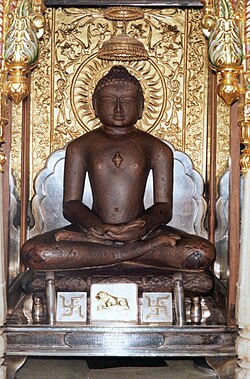
Back Mahavira Afrikaans Mahavira ALS ماهافيرا Arabic ماهافيرا ARZ মহাবীৰ Assamese Mahavira Azerbaijani Махавира Bulgarian महावीर Bihari মহাবীর Bengali/Bangla Mahavira Catalan
| Mahavira | |
|---|---|
24th Tīrthaṅkara | |
 The idol of Lord Mahavira at Shri Mahaveer Ji Atishaya Kshetra, Karauli district of Rajasthan. | |
| Other names | Vira, Ativira, Vardhamana, Sanmatinatha[1][2][3][4][5] |
| Venerated in | Jainism |
| Predecessor | Pārśvanātha |
| Successor | Padmanābha / Mahāpadma (first Tirthankara of the ascending next half of time-cycle)[6] |
| Mantra | Śrī Mahāvīrāya Namaḥ |
| Symbol | Lion[7] |
| Age | 72 |
| Tree | Shala |
| Complexion | Golden |
| Festivals | Mahavira Janma Kalyanaka, Dipalikaya |
| Genealogy | |
| Born | Vardhamāna c. 599 BCE (traditional)[8] uncertain, possibly c. 6th or early 5th century BCE (historical)[8][9][10][11] Kshatriyakund, (Shvetambara)[1][12] Kundalpur/Kundapur, (Digambara)[13] Nāya Republic or Nātha clan, Vajjika League (present-day Nalanda district, Bihar, India) |
| Died | 527 BCE (traditional)[8][14][15][16] uncertain, possibly c. late 5th century BCE (historical)[8][9][10] Pawapuri, Magadha, Haryanka Empire (present-day Nalanda district, Bihar, India) |
| Parents |
|
| Siblings | Nandivardhana Sudarśanā (Śvetāmbara) |
| Spouse | Yaśodā (Śvetāmbara) Unmarried (Digambara) |
| Children | Priyadarśanā, also known as Anojjā (Śvetāmbara) |
| Dynasty | Ikshvaku dynasty |
| Part of a series on |
| Jainism |
|---|
 |
Mahavira (Devanagari: महावीर, Mahāvīra), also known as Vardhamana (Devanagari: वर्धमान, Vardhamāna), was the 24th Tirthankara (Supreme Preacher and Ford Maker) of Jainism. Although the dates and most historical details of his life are uncertain and varies by sect, historians generally consider that he lived during the 6th or 5th century BCE,[17][9] reviving and reforming a proto-Jain community (which had possibly been founded by Parshvanatha),[18][19] and he was an older contemporary of Gautama Buddha.
Jains regard him as the spiritual successor of the 23rd Tirthankara Parshvanatha.[20] According to traditional legends, Mahavira was born in the early 6th century BCE to a royal Kshatriya Jain family of ancient India. His mother's name was Trishala and his father's name was Siddhartha. According to the second chapter of the Śvētāmbara Ācārāṅga Sūtra, Siddhartha and his family were devotees of Parshvanatha.[21][22] Mahavira abandoned all worldly possessions at the age of about 30 and left home in pursuit of spiritual awakening, becoming an ascetic. Mahavira practiced intense meditation and severe austerities for twelve and a half years, after which he attained Kevala Jnana (omniscience). He preached for 30 years and attained moksha (liberation) in the 6th century BCE, although the year varies by sect. (Many historians[8][9][10] now believe his lifetime was later, by as much as one century, than was stated in tradition.)
Mahavira taught attainment of samyak darshan or self realization (atma-anubhuti) through the practice of bhedvijnāna, which involves positioning oneself as a pure soul, separate from body, mind and emotions, and being aware of the soul's true nature; and to remain grounded and steadfast in soul's unchanging essence during varying auspicious or inauspicious external circumstances. He also preached that the observance of the vows of ahimsa (non-violence), satya (truth), asteya (non-stealing), brahmacharya (chastity), and aparigraha (non-attachment) are necessary for spiritual liberation. He taught the principles of Anekantavada (many-sided reality): syadvada and nayavada. Mahavira's teachings were compiled by Indrabhuti Gautama (his chief disciple) as the Jain Agamas. The texts, transmitted orally by Jain monks, are believed to have been largely lost by about the 1st century CE.
Mahavira is usually depicted in a sitting or standing meditative posture, with the symbol of a lion beneath him. His earliest iconography is from archaeological sites in the North Indian city of Mathura, and is dated from between the 1st century BCE and the 2nd century CE. His birth is celebrated as Mahavir Janma Kalyanak while his nirvana (liberation) and attainment of Kevala jnana (omniscience) by Gautama Swami are observed by Jains as Diwali.[23]
Jains celebrate Mahavir Janma Kalyanak every year on the 13th day of the Indian Calendar month of Chaitra.[24]
- ^ a b Dundas 2002, p. 25.
- ^ Davidson & Gitlitz 2002, p. 267.
- ^ Kailash Chand Jain 1991, p. 38.
- ^ Jaini 2000, p. 9.
- ^ Hubbard 1807, p. 310.
- ^ Dundas 2002, p. 276.
- ^ Tandon 2002, p. 45.
- ^ a b c d e Dundas 2002, p. 24.
- ^ a b c d Kuiper 2010, p. 144.
- ^ a b c Shah 1999.
- ^ Doniger 1999, p. 549.
- ^ Doniger 1999, p. 682.
- ^ "Jain Mandir, Kundalpur". Bihar State Tourism Development Corporation. Retrieved 20 May 2024.
- ^ LLP, Adarsh Mobile Applications (20 July 2024). "Lakshmi Puja Timings for Amsterdam, North Holland, Netherlands". Drikpanchang. Retrieved 20 July 2024.
- ^ "Pawapuri". Official website of District Administration of Gaya. Retrieved 15 October 2015.
- ^ "Pawapuri". National Informatics Centre. Archived from the original on 22 July 2015. Retrieved 15 October 2015.
- ^ Dundas 2002, pp. 24–25.
- ^ Dundas 2002, pp. 30–31.
- ^ Basham 1951, p. 108.
- ^ Heehs 2002, p. 90.
- ^ Kailash Chand Jain 1991, p. 32.
- ^ Dundas 2002, p. 30.
- ^ Singh, Nagendra Kr; Mishra, A. P. (2005). Encyclopaedia of Oriental Philosophy and Religion: Christianity. Global Vision Publishing House. ISBN 978-81-8220-071-5.
- ^ "Mahavir Jayanti | What, When, Why & How To Celebrate Mahavir Swami Jayanti". 17 April 2021. Retrieved 2 April 2022.
© MMXXIII Rich X Search. We shall prevail. All rights reserved. Rich X Search